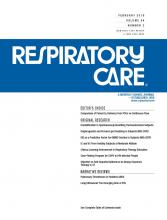We thank Drs Gruet and Saynor for their insightful comments on our article, “Functional tests of leg muscle strength and power in adults with cystic fibrosis.”1 We believe that the comments they raised have stimulated an interesting discussion on the clinical implications of our study. First, Gruet and Saynor correctly stated that there are no reference values from age-matched healthy controls for the 4 tests selected for our study (stair-climb power test, 30-s sit-to-stand test, vertical jump height, and triple hop distance). We agree that, to establish a “diagnosis” or to determine the degree of functional impairment, as a percentage of predicted, we certainly need some normative values for comparison. Nevertheless, in clinical practice, many times, it is the change over time that is important to evaluate progression of disease. In certain circumstances, a comparison of an individual's own baseline may be more meaningful than the percentage of predicted compared with normative data from healthy controls. This is especially so with chronic diseases, for example, cystic fibrosis. For example, sometimes the change of lung function, that is FEV1, is used as one of the criteria to define cystic fibrosis pulmonary exacerbation or to determine the effectiveness of clinical interventions during a pulmonary exacerbation. Therefore, we think that, even without appropriate age-matched normative reference values for the tests at this point, these 4 tests still have their usefulness clinically for assessment of the change over time in leg muscle strength and power in adults with cystic fibrosis. Besides, it is often debatable about the most appropriate “control” for people with cystic fibrosis. When healthy people are used as controls in cystic fibrosis studies, it always raises the question whether the differences in the outcomes are due to a respiratory disease or are specifically due to the condition of cystic fibrosis. To overcome this issue, Wells et al2 included subjects with primary ciliary dyskinesia as a “respiratory comparison group” to control for the effects of impaired respiratory function on their outcome of interest, skeletal muscle metabolism. Further discussion is needed to decide on the best controls for people with cystic fibrosis.
Second, we agree with Gruet and Saynor that the vertical jump test and triple hop distance tests require motor skills, coordination, and good balance to perform well. For this reason, in our study, we ensured that the tester first demonstrated the task and that the subjects were allowed to have a trial run before the measurements were made. The subjects repeated each test 3 times, and the average score was used for analysis to account for variability in performance. Also, none of our subjects experienced difficulties or loss of balance while performing any of the functional tests, although, we only had a small sample. We suggest that when conducting these tests clinically similar procedures should be followed. Reliability studies of these tests in larger samples of adults with cystic fibrosis would be informative to clinicians and researchers.
Third, we agree with Gruet and Saynor that it would be ideal to conduct an objective measure of muscle strength in the clinical setting. The fixed strain gauge and fixed hand-held dynamometer have good reliability for quadriceps strength testing and are more feasible than computerized dynamometry to conduct in a clinical setting.3,4 Given the limited resources in many clinical settings (eg, cost, time constraints, and space availability), we suggest that implementation studies be conducted in out-patient and in-patient settings with patients with cystic fibrosis to further understand the barriers and facilitators of implementing muscle strength testing clinically.5 Until there is greater uptake of muscle strength assessment in clinical practice, we suggest that functional tests, for example, the stair-climb power test, can be used by clinicians to evaluate lower extremity function in adults with cystic fibrosis.
In conclusion, we think that functional tests, for example, the stair-climb power test, are useful and safe tools, for clinical assessment of change over time in leg muscle strength and power in adults with cystic fibrosis. Future studies on their clinical utility and implementation will provide further support for the clinical use of functional tests. With a better understanding of the clinical implications of skeletal muscle weakness in cystic fibrosis, we anticipate that more emphasis, and therefore resources, will be placed on the assessment of muscle strength, and direct measures of muscle strength with fixed strain gauge can be incorporated into clinical practice. However, the lag between knowledge generation to practice implementation must also be considered.
Footnotes
- Correspondence: Sunita Mathur, Department of Physical Therapy, University of Toronto, 160-500 University Ave, Toronto ON M5G 1V7, Canada. E-mail: sunita.mathur{at}utoronto.ca.
The authors have disclosed no conflicts of interest.
- Copyright © 2019 by Daedalus Enterprises











